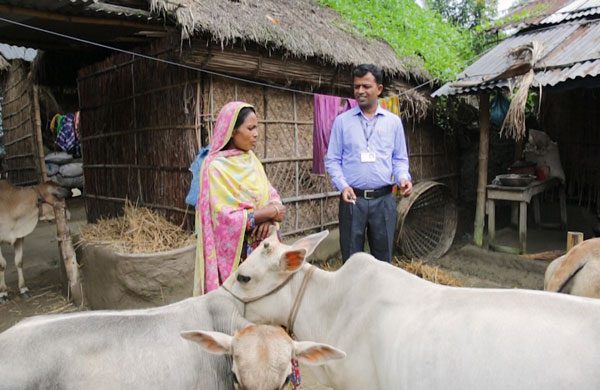Going Google: Betting big on artificial intelligence for development
Reading Time: 3 minutes
For an organisation like BRAC, the implications of using AI to better understand clients needs has limitless potential. Imagine the students from our 20,000 schools getting customised feedback on their learning needs. With our vision centres in place, aiming to complete 1 million eye check-ups in the next two years, an Aravind-esque project is not a distant reality to provide better support to medical professionals.
Google I/O 2018 was exciting, fun, full of new innovations and most of all, about the tremendous potential that artificial intelligence brings to augment human capabilities. Google is betting big on AI and one clear manifestation of that intent was the rebranding of Google Research division to simply, Google AI. As a company which has always been the trendsetter in the global technology landscape, bar a few exceptions (Google Plus, anyone?), Google has reiterated its commitment to go big with AI in their annual gathering of developers and partners.
Starting from the very beginning of CEO Sundar Pichai’s keynote, where he emphasised on the need for bringing in new innovation in the field of AI through new products, to demos which got a stadium full of 7,000 people cheering their hearts out- it was made sure that Google’s AI has arrived and it’s not taking any prisoners! Sessions experienced by millions of people from different countries, the environment in Shoreline Amphitheatre, the venue of the I/O, was electrifying. Some 7,000 coders, developers, engineers, technologists and tech enthusiasts gathered up to see what Google had to offer to the whole world in 2018. Google didn’t disappoint.

The Shoreline Amphitheatre in Mountain View, CA – packed with 7,000 excited tech enthusiasts.
The most applauses and excitement was reserved for that one instance when a recording of an actual call made by the Google Assistant making a reservation with a human employee of a barber shop was played during Pichai’s demo. It was eerily human-like and full of human expressions. There are already ethical debates about this going public but this just shows how fast AI is learning to mimic human behaviour.
The following keynotes also shared exciting new updates on Maps, Android, Lens and a revamped News app. The jazzed up version of the Google Map, which will combine real images with navigation tools got a huge approval from the crowd, proving how popular the service is with people of all ages. The days of the solitary blue dot representing you on a digital map is limited.
Being a huge tech enthusiast but a non-coder/developer meant that I missed out on a number of events designed for experts. But this year’s I/O had all kinds of sessions and engagement opportunities starting from more broader discussions around different areas like the applications of machine learning, AI and big data to experience zones where attendees could learn about the more wackier usage of Google tools.
There was considerable excitement about the sessions combining AI and machine learning to support healthcare. Jessica Mega from Alphabet’s Verily, a healthtech company which ventured out of Google and Google X, talked about how deep learning, a type of machine learning, and AI is helping doctors diagnose for diabetic retinotherapy (diabetes induced preventable blindness). The pilot they are doing right now with Aravind Eye Hospital in India is showing great early results and can be easily scaled with other healthcare service providers.
Another packed session that stood out was on how technology can help change the lives of people for the better. Moderated by Google.org’s president Jacquelline Fuller, the panel included non-profit founders. Jess Ladd, founder of Callisto, a reporting platform for sexual assaults, passionately talked about her own trauma and how it guides her current work of giving other victims of sexual assault a tool to fight back. Alex Bernadotte, the founder of Beyond 12, an online coaching and mentoring platform for young people, pointed out that technology is never going to replace humans as in her platform as well, human mentors are supported by Google’s tech.
One thing that came up from I/O 2018 very strongly is that Google is thinking about the digital wellbeing of its users and it was evident from the modifications to their existing and new products. For example, the simple act of greying out your screen after a pre-designated sleeping time will give your brain the much needed willpower to stave off the smartphone!
If Google’s predictions are right then we have an exciting time ahead of us as AI starts to get more intelligent and all pervasive. The example from India shows that the bottom billion can also benefit from its advances and the opportunities that it creates. How we choose to use it is up to us.
For an organisation like BRAC, the implications of using AI to better understand the needs of our clients have limitless potential. Imagine the students from our 20,000 schools getting customised feedback on their learning needs from their teacher who is aided by an AI- which analyses thousands of data points and predicts which student needs help with what. With our vision centres in place, aiming to complete 1 million eye check-ups in the next two years, an Aravind-esque project is not a distant reality to provide better support to medical professionals.
Future tech-driven utopian ideas will surely raise a few eyebrows and invite quite relevant criticism. The important thing to remember in here is technology is just means to an end and not the end itself. As Atul Gawande, the public health researcher, put it, “We yearn for frictionless, technological solutions. But people talking to people is still the way that norms and standards change.”
Rakib Avi is the programme manager of BRAC’s Social Innovation Lab.





